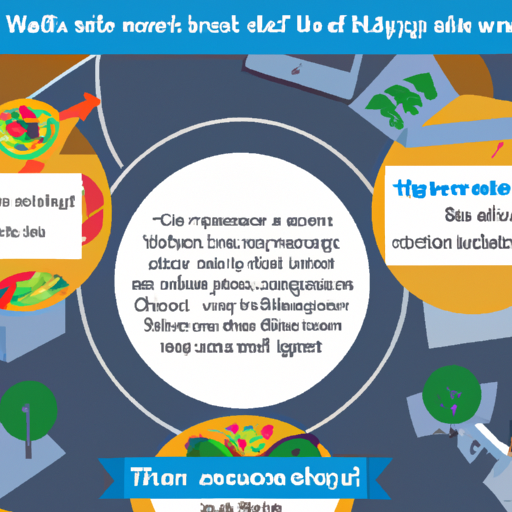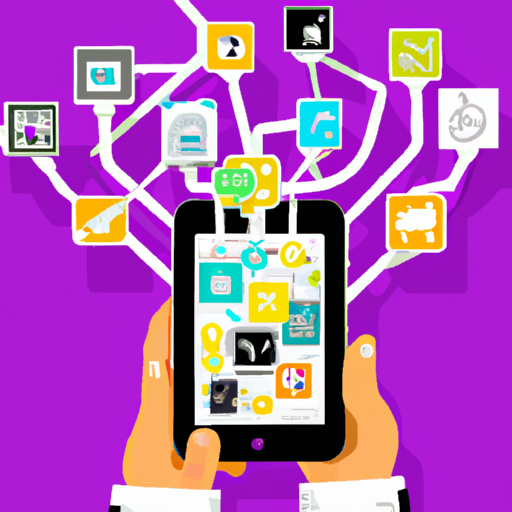Banking Technology Trends
In today’s fast-paced world, the banking industry is constantly evolving to keep up with the rapid advancements in technology. From mobile banking to artificial intelligence, banking technology trends are reshaping the way we manage our finances. This article explores the latest innovations in the banking sector, unveiling the exciting possibilities that lie ahead for both consumers and financial institutions. Get ready to glimpse into the future of banking and discover how technology is revolutionizing the way we interact with our money.
Table of Contents
Digital Banking

Mobile banking apps
Mobile banking apps have revolutionized the way we manage our finances. With the convenience of accessing your bank account through your smartphone, you no longer have to visit a physical branch to perform basic transactions. Mobile banking apps allow you to check your account balance, transfer funds, pay bills, and even deposit checks simply by using your phone. These apps often offer additional features such as spending trackers, alerts for suspicious activities, and budgeting tools, providing you with greater control over your finances.
Online banking platforms
Online banking platforms have become increasingly popular as they offer a range of services that can be accessed through a web browser. With online banking, you can manage your accounts, pay bills, transfer funds, and view statements all from the comfort of your own home. These platforms provide real-time updates on your account balance and transactions, enabling you to easily keep track of your financial activities. Online banking also offers added security measures such as two-factor authentication and encryption, ensuring that your personal information remains protected.
Open banking
Open banking is a concept that aims to give individuals greater control over their financial data. It allows third-party financial service providers to access and utilize your banking information with your consent. This means that you can use one app or platform to manage multiple bank accounts, credit cards, and other financial accounts from different institutions. Open banking promotes innovation and competition in the banking industry, as it encourages the development of new services and products that can enhance your banking experience.
Biometric authentication
Biometric authentication is revolutionizing the way we secure our financial transactions. Instead of relying on traditional methods such as passwords or PINs, biometric authentication uses unique physical characteristics, such as fingerprints, facial recognition, or iris scans, to verify your identity. This provides a higher level of security since it is difficult to replicate or forge these features. Biometric authentication not only enhances security but also offers convenience, as you no longer have to remember complex passwords or carry multiple authentication devices.
Artificial Intelligence
Chatbots and virtual assistants
Chatbots and virtual assistants are becoming increasingly common in the banking industry. These AI-powered systems can interact with customers in a natural language format, providing real-time assistance and answering queries. They can help customers with basic banking tasks, such as checking account balances, transferring funds, or initiating bill payments. Chatbots are available 24/7, providing instant support and reducing the need to wait in long customer service queues. Virtual assistants can also offer personalized recommendations based on your spending patterns and financial goals, helping you make informed decisions.
Intelligent analytics
Intelligent analytics leverages AI algorithms to process and analyze vast amounts of banking data to derive valuable insights. This technology allows banks to identify patterns, trends, and anomalies in customer behavior and transaction data. By analyzing this information, banks can offer personalized services, such as tailored product recommendations or targeted marketing campaigns. Moreover, intelligent analytics can help banks detect fraudulent activities and mitigate risks by flagging suspicious transactions in real-time. This technology ultimately allows banks to improve operational efficiency, enhance customer experiences, and make data-driven decisions.
Robotic process automation
Robotic process automation (RPA) refers to the use of software robots or “bots” to automate repetitive tasks and processes in the banking industry. These bots can perform tasks such as data entry, document verification, and account reconciliation with speed and accuracy. By automating these manual processes, banks can improve operational efficiency, reduce costs, and minimize errors. RPA also frees up human employees to focus on more value-added tasks, such as providing personalized customer service or strategic decision-making.
Blockchain and Cryptocurrencies
Decentralized ledger technology
Blockchain technology is a decentralized ledger system that enables secure and transparent transactions. In the context of banking, blockchain can revolutionize payment systems by eliminating the need for intermediaries and reducing transaction costs. With blockchain, transactions are recorded on a distributed ledger, which is verified by a network of computers, ensuring transparency and immutability. This technology also enhances security, as all transactions are encrypted and linked in a chronological order. Moreover, blockchain can enable faster cross-border transactions, as it eliminates the need for multiple correspondent banks.
Smart contracts
Smart contracts are self-executing contracts with the terms of the agreement directly written into code. These contracts are stored on a blockchain network and automatically execute when predefined conditions are met. In the banking industry, smart contracts can be used to automate various processes, such as loan approvals or insurance claims. By eliminating the need for intermediaries, smart contracts reduce costs and enhance efficiency. Additionally, the transparency and immutability of blockchain ensure that all parties involved in the contract can trust the process and verify its execution.
Stablecoins
Stablecoins are a type of cryptocurrency that aims to minimize price volatility by pegging their value to an underlying asset, such as fiat currency or commodities. These cryptocurrencies offer a more stable and predictable means of exchange compared to other cryptocurrencies, such as Bitcoin or Ethereum. Stablecoins can be used for various banking purposes, such as remittances, cross-border payments, or as a store of value. They provide an efficient and cost-effective alternative to traditional fiat currencies, especially in regions with unstable or inflationary currencies.
Cybersecurity
Enhanced authentication methods
As technology evolves, so do the methods used by cybercriminals to gain unauthorized access to sensitive information. To counter these threats, banks are adopting enhanced authentication methods to protect their customers’ accounts. These methods include biometric authentication, multi-factor authentication, and one-time passwords. By combining multiple verification factors, banks can ensure that only authorized individuals can access online and mobile banking platforms, reducing the risk of identity theft and fraud.
Behavioral biometrics
Behavioral biometrics is a form of authentication that analyzes patterns in user behavior to identify anomalies and detect potential security threats. By monitoring factors such as typing speed, mouse movements, or swipe patterns, banks can build a unique profile for each individual customer. If a customer’s behavior deviates from their usual patterns, the system can trigger an alert and prompt additional verification steps. Behavioral biometrics not only improves security but also enhances the user experience by providing a seamless authentication process.
Advanced encryption
Encryption plays a critical role in safeguarding sensitive data, such as financial transactions or customer information. Banks employ advanced encryption techniques to protect data during transmission and storage. These encryption protocols ensure that data is encrypted using complex algorithms, making it virtually impossible for unauthorized individuals to decipher. By utilizing robust encryption methods, banks can maintain the confidentiality and integrity of customer data, protecting them from cyber threats and potential data breaches.
Threat intelligence
Threat intelligence refers to the proactive identification and analysis of potential cyber threats. Banks gather and analyze threat intelligence from various sources, such as security vendor reports, industry publications, and government agencies. This information helps banks identify emerging threats, vulnerabilities, and attack patterns. Armed with this knowledge, banks can develop proactive security measures to mitigate risks and protect their customers’ financial assets. Threat intelligence allows banks to stay one step ahead of cybercriminals and ensure the security of their digital banking systems.
Big Data and Analytics

Data-driven decision making
Banks generate and store massive amounts of data on a daily basis. By leveraging big data and analytics, banks can extract valuable insights from this data to drive informed decision-making. Analyzing customers’ transaction histories, spending patterns, and credit scores can provide banks with a deeper understanding of their customers’ needs and preferences. This data-driven approach allows banks to tailor their product offerings, develop targeted marketing campaigns, and allocate resources more effectively. Data-driven decision making ultimately enables banks to deliver personalized experiences and strengthen customer relationships.
Predictive analytics
Predictive analytics encompasses the use of statistical models and machine learning algorithms to forecast future events or behaviors. Banks can use predictive analytics to assess the creditworthiness of loan applicants, predict customer churn, or identify potential investment opportunities. By analyzing historical data and identifying patterns, predictive analytics provides banks with insights that can help them make accurate predictions and informed decisions. This technology enables banks to proactively address customer needs, reduce risks, and optimize their operations.
Customer personalization
Personalization is becoming increasingly important in the banking industry. By analyzing customer data and behavior, banks can provide personalized recommendations, offers, and experiences. With the help of big data analytics, banks can understand customers’ preferences, anticipate their needs, and tailor their products and services accordingly. For example, banks can offer targeted financial advice, personalized investment portfolios, or customized loan terms. Customer personalization not only enhances customer satisfaction but also helps banks develop long-term relationships and foster customer loyalty.
Cloud Computing
Reduced IT costs
Cloud computing offers banks the opportunity to reduce their IT costs significantly. Instead of investing in expensive hardware infrastructure and maintaining data centers, banks can leverage cloud service providers that offer flexible and scalable solutions. Cloud computing allows banks to pay for the resources they need, reducing upfront capital expenditure. Moreover, cloud service providers handle the maintenance, security, and software updates, freeing up IT resources and enabling banks to focus on their core banking functions.
Improved scalability and flexibility
Cloud computing provides banks with the ability to scale their operations quickly and effortlessly. As banking technology trends and customer demands evolve, banks can easily scale their computing resources to accommodate increased traffic, launch new services, or expand into new markets. Cloud computing also offers flexibility as banks can quickly adapt to changing business requirements and experiment with new technologies or applications without significant upfront costs. This agility ensures that banks remain competitive in the fast-paced banking industry.
Enhanced collaboration and accessibility
Cloud computing enables seamless collaboration and access to data and applications for bank employees across different locations. Employees can securely access the necessary information and tools from anywhere using internet-connected devices. This flexibility empowers banks to adopt remote or flexible work arrangements, facilitate efficient communication between teams, and expedite decision-making processes. Furthermore, cloud-based collaboration platforms promote efficient workflows, document sharing, and version control, improving productivity and eliminating geographical barriers within the organization.
Augmented Reality and Virtual Reality
Virtual banking experiences
Augmented reality (AR) and virtual reality (VR) technologies have the potential to transform the banking experience. By using AR, banks can overlay digital information onto the physical environment, providing customers with real-time information and guidance during their banking transactions. For example, customers can use AR to view mortgage rates or loan terms when visiting a property. VR, on the other hand, can be used to create immersive virtual banking environments, where customers can virtually explore bank branches, attend financial workshops, or even participate in interactive financial simulations.
Immersive virtual tours
VR technology can be utilized to provide immersive virtual tours of bank branches and facilities. This allows potential customers to explore the bank’s facilities and services without physically visiting a branch. Virtual tours can showcase key features and services, such as personalized banking advice or investment portfolios, in a visually engaging and interactive manner. This technology not only enhances accessibility, especially for customers who are unable to visit a physical branch, but also helps banks create a memorable and engaging customer experience.
AR-powered customer support
AR can be leveraged to enhance the customer support experience by providing real-time assistance and guidance. For instance, customers using a mobile banking app can use AR to scan a document, and the app can overlay instructions on how to fill out the document correctly. AR-powered customer support can reduce errors, streamline processes, and minimize the need for customers to contact a support representative. This technology also enables banks to deliver personalized support at scale, as AI-powered virtual assistants can use AR to guide customers through complex transactions or troubleshoot common issues.
Internet of Things
Connected devices for payments
The Internet of Things (IoT) enables connected devices, such as smartwatches, fitness trackers, or even home appliances, to complete payments securely. Banks can leverage IoT technologies to offer contactless payments, where devices can communicate with payment terminals and complete transactions without the need for physical cards. This technology provides convenience and enhances the customer experience, as payments can be made seamlessly and swiftly. IoT also enables banks to gather real-time data on customer behavior, allowing them to offer personalized recommendations and rewards.
Smart branches and ATMs
IoT can enhance the functionalities of bank branches and ATMs, delivering a more personalized and efficient experience for customers. Smart branches equipped with IoT sensors can provide real-time information on customer footfall, enabling banks to optimize staff allocation and streamline operations. ATMs connected to the IoT can proactively detect maintenance issues, reducing downtime and improving customer satisfaction. Furthermore, IoT-enabled ATMs can offer personalized services, such as cash withdrawal options tailored to individual customer preferences based on their transaction history and banking habits.
Data-driven personalized offers
The IoT generates vast amounts of data through connected devices, which can be leveraged by banks to offer personalized product recommendations and targeted offers. By analyzing data from devices such as fitness trackers or smart home systems, banks can understand customers’ spending habits, preferences, and lifestyles. Armed with this valuable information, banks can offer personalized credit card rewards, insurance plans, or loan options that cater to each customer’s unique needs. This level of personalization not only improves customer satisfaction but also increases the likelihood of cross-selling and upselling opportunities for banks.
Robotic Process Automation
Automated customer onboarding
Robotic process automation (RPA) can streamline and automate the customer onboarding process, making it faster and more efficient. RPA bots can collect and verify customer data, perform identity verification checks, and populate relevant forms and documents. By automating these manual processes, banks can reduce errors, eliminate redundant tasks, and accelerate the onboarding process. This allows banks to provide a seamless and frictionless experience for customers, enhancing satisfaction and reducing the risk of customer abandonment.
Streamlined back-office operations
RPA can also be applied to streamline back-office operations, such as accounts payable, reconciliations, or compliance checks. RPA bots can automate repetitive tasks, such as data entry or report generation, freeing up human employees to focus on more strategic and value-added activities. By automating these processes, banks can improve operational efficiency, reduce costs, and minimize errors. The use of RPA in the back-office also contributes to improved compliance and data accuracy, as bots can perform repetitive tasks with consistent precision.
Cost reduction and efficiency improvement
Overall, RPA enables banks to achieve significant cost reductions and efficiency improvements. By automating manual processes and eliminating the need for human intervention, banks can reduce operational costs and increase productivity. RPA ensures consistent and accurate execution of tasks, reducing the risk of errors and subsequent rework. The time saved through automation allows banks to allocate resources to value-added activities, such as customer service or strategic decision-making. Additionally, the scalability of RPA enables banks to adapt quickly to changing business needs and efficiently handle fluctuations in transaction volumes.
Regulatory Technology
Compliance automation
Compliance with regulatory requirements is a critical aspect of the banking industry. Regulatory technology (RegTech) solutions leverage automation and advanced analytics to streamline compliance processes and ensure adherence to regulations. These solutions can monitor transactions in real-time, detect suspicious activities, and generate automated reports required by regulatory bodies. By automating compliance processes, banks can reduce the risk of non-compliance, minimize manual errors, and significantly save time and resources.
Risk management solutions
Risk management is a fundamental component of the banking industry. RegTech solutions can assist banks in identifying, assessing, and mitigating risks effectively. These solutions leverage data analytics and machine learning algorithms to detect patterns, anomalies, and potential risks in real-time. By providing timely and accurate risk insights, banks can make informed decisions and take appropriate actions to mitigate risks. RegTech solutions also assist banks in complying with risk management frameworks and regulatory requirements, ensuring that risk is managed proactively and efficiently.
Anti-money laundering tools
Money laundering poses a significant risk to the banking industry and requires diligent efforts to prevent. RegTech solutions provide banks with advanced tools and technologies to detect and prevent money laundering activities. These solutions use data analytics and AI algorithms to monitor customer transactions, identify suspicious patterns, and generate alerts for potential money laundering activities. By leveraging these tools, banks can comply with anti-money laundering regulations, enhance their risk management processes, and protect themselves and their customers from financial crimes.
In conclusion, banking technology trends are transforming the way we handle our finances. Digital banking, with its mobile apps and online platforms, offers convenience and accessibility. Artificial intelligence enables personalized customer experiences and data-driven decision-making. Blockchain and cryptocurrencies provide secure and transparent transactions. Cybersecurity solutions protect against online threats. Big data analytics allow for better insights and personalized services. Cloud computing offers cost savings and improved scalability. Augmented reality, virtual reality, and the Internet of Things enhance customer interactions. Robotic Process Automation streamlines operations, and Regulatory Technology automates compliance processes. With the continuous advancement of technology, banking is evolving, providing us with more efficient, secure, and personalized financial services.






